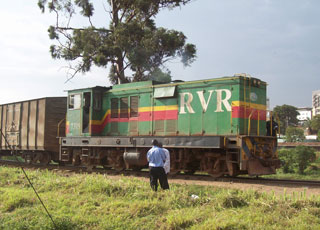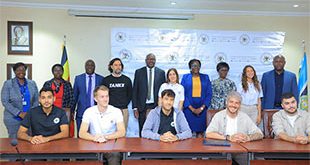
By Patrick Kagenda
Kenya, Uganda governments stuck with bad concession over legal complications
When it was signed in November 2006, the Uganda and Kenya governments’25-year concession to Rift Valley Railways (RVR) to run the operations of the Uganda Railway Corporation and the Kenya Railway Corporation was hailed as the “deal of the year” by Euromoney. Euromoney is one of the world’s leading financial magazines. Barely two years after, RVR is embroiled in myriad court cases, its shareholding has changed twice, and operations of the Mombasa-Kampala rail line have gone from bad to worse.
After issuing a string of ultimatums, Uganda and Kenya want out but RVR has them tied in legal hot wire.
Last week, the Kenya government which has been most frantically pushing to get lose, suffered a body blow when poor performing RVR successfully swung a legal suit to cling to its 25-year concession. Just a day to the expiry of the latest ultimatum of January 15 for it to inject US$ 40 million or lose the concession, RVR won a court order blocking termination of its contract.
Around the same time, the RVR Executive Chairman Brown Ondego told journalists in Nairobi that RVR could not completely improve its operations unless the Kenya and Uganda governments give consent for the reduction of shares of the lead investor, Sheltam Railways Company of South Africa.
Under the current arrangement, Sheltam owns 35% of RVR while TransCentury owns 20%, and Centum Investment, Babcok, and Brown Investment each controls 10%.
Media sources quoting anonymous shareholders claim they are unhappy that although they have injected about US$30 million into RVR, Sheltam, which is financially weak, has not contributed a penny since it was awarded the tender.
The shareholders say the only way they can put new money into the company is by either offering shares to new share holders or offering existing shareholders new shares in a rights issue.

Sheltam’s shareholding has already been diluted before. When it first won the concession, Sheltam controlled 61% of RVR in a consortium with Prime Fuels Ltd (Kenya, 15%); Comazar (Pty) Ltd (South Africa, 10%); Mirambo Holding Ltd (Tanzania, 10%), and CDIO Institute for Africa Development Trust (South Africa, 4%).
The move to further reduce Sheltam’s shareholding appears designed to give the new Kenyan-dominated RVR management more elbow room.
Mr Ondego, who was managing director of the Kenya Ports Authority before he was sacked, is a close ally of Kenya’s Prime Minister Raila Odinga. Mr Raila Odinga is Kenya’s pointsman in the RVR saga.
If RVR operations either do not improve or grind to a total halt in the next few months, Ugandan consumers will suffer more but the Kenya economy will lose most.
Africa absorbed 46.8 percent of Kenya’s goods during 2008, with the top destinations being Uganda (12.3 percent). Exports from Kenya to the COMESA region also increased to US$1,578 million (32.2 percent of total exports) in the year ending October 2008, from US$1,229 million for the same period the year before. The increase was largely attributed to exports to Rwanda, Sudan and Uganda. Over the same period, Uganda’s major export destination was Sudan at US$ 157 million. Kenya followed in close second place.
However, even minor interruptions in the supply of commodities from Kenya cause major disruptions in Uganda that are yet to be quantified in money terms. The escalation of commodity prices, especially fuel, in Uganda due to the December 2007post-election violence in Kenya still linger a year later.
Not surprisingly, therefore, Uganda has been more reluctant to terminate the RVR contract because of the likely disruption in the supply chain.
Although Kenya has so far benefited more from the arrangement under RVR- with Ugandan officials claiming that RVR shifted Uganda wagons and rolling stock to provide internal services in Kenya “” Uganda stands to lose less on paper. Ugandan entities have made little or no capital investment in RVR. In fact, it is only in the recent September 2008 restructuring that a Ugandan, Mr Charles Mbire, was named on the RVR board.
In the current saga, Uganda is blowing hot and cold.
Mr Jim Mugunga, the spokesman of the Privatisation Unit in the Ministry of Finance under whose docket RVR falls claims the government of Uganda has never given RVR any ultimatum.
“Kenya has been giving notices of intent to terminate the concession but Uganda has never given any. There is a consultative process on going and an understanding is soon being reached,” he told The Independent in an interview last week.
But that position was contradicted by the Minister of State for Works and Transport, Mr John Byabagambi.
“It is true the governments of Uganda and Kenya gave an ultimatum and now there is a process going on in effect to that,” Byabagambi told The independent around the same time, “We are moving slowly because termination is also a process which you can’t do in one day. Within a month’s time we will have the real status of the concession agreement.”
Byabagambi said this implies that the two governments have started the process of terminating the concessionaire.
He said: “After termination there will be a fall back and that fall back is our duty in the ministry of transport to see that there is no interruption in the flow of the smooth running of the railways. However the government of Uganda and that of Kenya have formed a joint committee which is composed of the Ministers of works, finance and justice in both countries to handle the fallback.”
Uganda also appears constrained because of the legal implications of any termination.
“The two governments need to prove that failure to perform was actually occasioned by the investor, and this is something the two governments should be able to bear in mind. The other implication is of repossessing the company and running it. That is why I will not confirm that an ultimatum has been given,” Mugunga said.
Mr Enos Tumusiime, a former managing director of URC, says Uganda is better off realizing that RVR has failed.
“If the person who is running three quarters of the route (Kenya) is not with the concessionaire then you don’t expect the concession to survive on the quarter of the route (Uganda),” he said.
If the RVR concession ended today, Uganda would have no locomotives and wagons to handle the export/import traffic.
Uganda’s only hope appears to be in the construction of a new line under different management from RVR.
But even if both governments appear to treat the project with urgency, the new standard gauge rail line can only be ready by 2017.
The new line is estimated to cost $ 3.5 billion (U Shs 6.8 trillion). This is against $ 500 million (U Shs 970 billion) that would be required to rehabilitate the old line over a period of five years.
The old line has capacity to carry 5 million tones of cargo annually while Mombasa port is currently handling 16 million tones annually which is projected to increase to 30 million tones by 2030.
At RVR offices in Kampala, workers were in a somber mood as their fate remains unknown. Preferring anonymity, they told The Independent, “When the services return to Uganda Railways Corporation, we won’t earn as much as we have been earning”.
Gang men who do the manual jobs of rail fixing and bush clearing have been bagging Shs 300,000 while the CEO has been earning a gross of Shs 18 million.
“Our bosses are keeping us in the dark, because they are not telling us the truth. But we have also heard that the contract was terminated.”
 The Independent Uganda: You get the Truth we Pay the Price
The Independent Uganda: You get the Truth we Pay the Price


